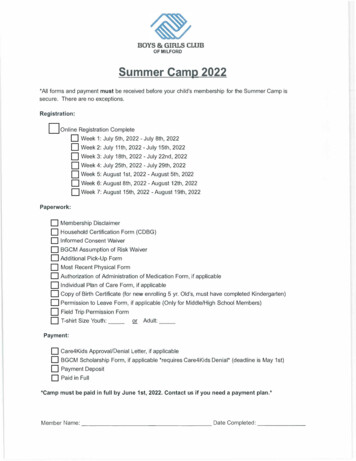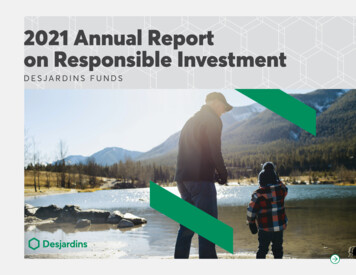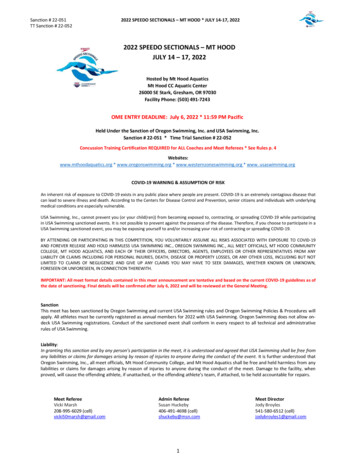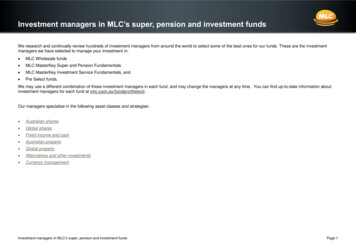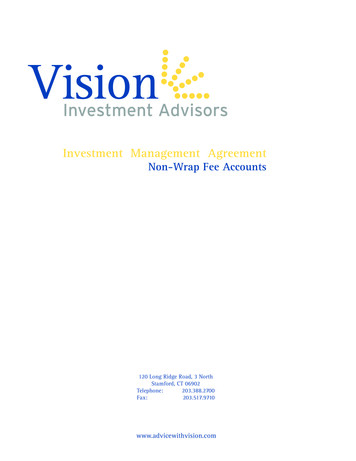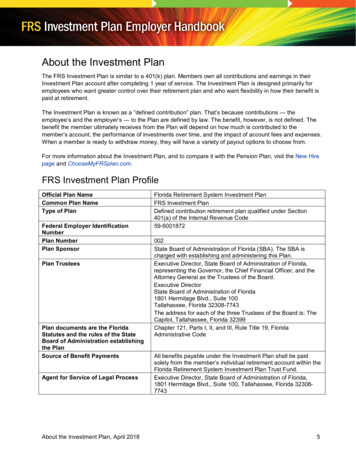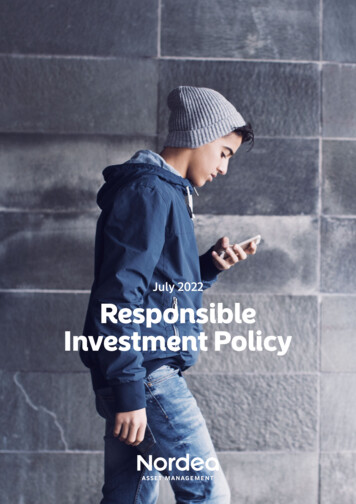
Transcription
July 2022ResponsibleInvestment Policy1
2
Index/1/ Purpose and scope42/ Advocacy and memberships63/ Our responsible investment approach83.1.NAM-level overlay103.1.1Norm-based screening103.1.2NAM-level PAI integration103.1.3NAM-level exclusion list103.1.4. Active ownership and engagement123.2.Product-specific approaches143.2.1The STARS strategies:proven leadership within responsible investment143.2.2NAM’s thematic ESG strategies143.2.3Other ESG products with enhanced exclusion filters154/ ESG positions165/ Reporting and transparency196/ Sustainable asset manager217/ Conflicts of interest223
1/Purpose and scopePurposeThe purpose of the Responsible InvestmentPolicy (the “Policy”) is to describe the frameworkgoverning the approach of Nordea AssetManagement (“NAM”) to responsible investmentsand ESG/sustainability. The Policy is approved bythe Nordea Asset Management Holding AB (“NAMHolding”) board and by the NAM ResponsibleInvestment Committee (the “RIC)”. The RIC includesmembers from the Senior Executive Managementteam and is chaired by the head of NAM, who is alsothe CEO of Nordea Asset Management Holding AB.The RIC is responsible for securing compliance withthe policy, decide on exclusions and engagementsas well as monitor engagements. NAM s ResponsibleInvestment team (the “RI team”) is responsible forthe maintenance and implementation of this Policy.4Nordea Asset Management’s mission is to createreturns with responsibility by being ESG-proactivedelivering excess returnsoffering access to the right assetsdemonstrating operationalexcellence and transparency maintaining industry-leading risk and perfor-mance management.By ESG we mean integrating environmental, social andgovernance factors into our invest-ment processes, observing bothsides of the “double materiality” actively engaging with our investeecompanies to ensure that they meet ourexpectations of sound ESG performance andcompliance with international norms offering a wide range of ESG solutions across allasset classes accepting the responsibility to act as an industryleader within ESG/sustainability.
ScopeNAM, or NAM Holding, which is the assetmanagement subsidiary of Nordea Bank Abp,includes Nordea Investment Management AB(“NIM”) and Nordea Investment Funds S.A.(“NIFSA”). NIM is a Swedish investment firmauthorised to, inter alia, provide discretionaryportfolio management services, and NIFSA is amanagement company authorised by the CSSF (theLuxembourg FSA) to manage UCITS and alternativeinvestment funds.This Policy applies to all Nordea-brandedinvestment strategies, with the exception of anyholdings by such strategies in external fundsand index derivatives and selected discretionarymandates on clients’ request.This Policy is reviewed and updated as required andat least annually.The concept of double materiality refers to, on the one hand,those ESG/sustainability risks that are material to the financialperformance of an investee company or other entity, and, on theother, to the environmental and social impact of the activitiesof the same company or entity. The two will typically be closelylinked, but should not be conflated.15
2/Advocacyand membershipsNAM became a signatory to the Principles for ResponsibleInvestments (the “PRI”) in 2007 and has offered productswith sectoral screening since 1988.Since 2020, we are a founding member of theNet Zero Asset Managers initiative. In 2019, NAMpublicly committed to aligning our investmentstrategies with the objectives of the ParisAgreement. This means that we have a long-termstrategic objective to reduce the greenhouse gasemissions impact of our investments in line with the“well below 2 C” ambition, increase our investmentsbased on climate-related opportunities and ensurethat our investment portfolios are resilient toclimate-related risks.Our Responsible Investment Policy aims for thecompanies we invest in to support the UnitedNations Sustainable Development Goals (SDG’s)and comply with international conventions andnorms, including, but not limited to: 6United Nations Global CompactOECD Principles of Corporate GovernanceOECD Guidelines for Multinational EnterprisesUniversal Declaration of Human RightsUN Guiding Principles on Business andHuman RightsChildren’s Rights and Business PrinciplesILO conventions on labour standardsRio Declaration on Environmentand DevelopmentUN Convention on CorruptionConvention on Cluster MunitionsFurther, we support standardised and integratedreporting which incorporates material sustainabilityinformation with financial information andprovides consistent and comparable ESG data,preferably using the SASB framework or similar.We also support and promote the adoption of therecommendations of the Task Force on Climaterelated Financial Disclosures (the TCFD).In this context, we actively engage with variousstandard-setters and stakeholders locally andinternationally. We are active members of the PRI,SASB, IIGCC, CDP, TPI, Finance for BiodiversityPledge and Investor Alliance for Human Rights.Nordea Asset Management adheres to theESG4Real standard for a select number of fundsand comply with the certification criteria throughthe integration of exclusion, norm based screeningand active ownership into the investment process.
7
3/Our responsibleinvestment approachWe believe that it is our fiduciary duty to deliver returnswith responsibility.NAM s responsible investmentframework builds on the PRI and spansfour main areas: general ESG integrationspecific ESG productsactive ownership and engagementexclusion.NAM has developed policies andprocedures to ensure that thecompanies we invest in meet ourexpectations of ESG performanceand that ESG risk/sustainability riskis managed in all our investmentprocesses. This is supported by a robustnorm-based screening process and theintegration of principal adverse impact(PAI) analysis2 . In addition, we considerand take a stance on an ongoing basis,across all our portfolios, on issuesrelating to climate change, controversialweapons, human rights etc. All of theabove inform our active ownership andengagement policy and our exclusionlist at the firm level – our “firm-leveloverlay”.For a substantial part of our assetsunder management, we employadditional ESG tools. These include thedeeper ESG integration and handson involvement of the ResponsibleInvestments team in our STARSstrategies and thematic strategies(including climate, social empowermentand gender diversity portfolios) and8our internally developed ESG scoringof investee companies. Many individualproducts also have sector-based orother exclusion criteria beyond thoseimplemented at the firm level.Given the size of NAM’s investmentuniverse across its various investmentboutiques and strategies, we use arange of external providers of ESG dataas well as internal research and ourproprietary ESG scoring platform. Thesedata providers and other data sourcesare assessed on an ongoing basisfor data quality, coverage and otherattributes.As for all ESG-oriented asset managersand asset owners, the dilemma ofchoosing between engagement andexclusion is a central one for NAM. Theargument for exclusion rests on theneed to clearly mark the limits of whichcorporate activity and/or behavioursare deemed acceptable and which arenot. The argument for engagement,on the other hand, recognises that thereal-world effect of exclusion can benegligible, at least in the short run.Whenever one market participant sellsoff a security, another, presumably withlower standards of propriety, is buyingit. Thus, it can be argued that retaininga security, engaging with the companyand – where applicable – voting at itsAGMs, is preferable. Added complexityis introduced by the likelihood that
exclusion by some investors may makea company with substandard practicesmore open to the engagement effortsof the remaining owners and thus toimproving its practices over a longertimeframe.At NAM we believe that there areactivities and types of behaviour thatcannot be reconciled with our missionof delivering returns with responsibility.Companies exhibiting these on anongoing basis are excluded from allNAM products. At the same time,there is a large category of economicactivities that exist in a grey zone,contributing profitably to one or moreof the SDGs, while potentially beingnegative with regard to others. Activitiesand companies in this category maybe excluded from many NAM products(see below for NAM’s product-specificapproaches and our Paris-alignedFossil Fuel Policy), while still beinginvestible for more traditional strategies.Assuming that engagement is mosteffective when it is supported by animplicit but clearly understood threat ofultimate exclusion, we believe that thisallows NAM to be more effective in itsengagement, up to the point where thedecision is taken to exclude a companyat the NAM firm level.2Beginning in Q2 2021, PAI is integrated acrossall NAM products with the exception of caseswhere data is not available, e.g. in the case ofsome funds-of-funds. Principal adverse impactindicators, as defined by the EU SFDR, capturethe environmental and social or “outward” part ofthe “double materiality”, as opposed to sustainability risk, which captures the financial materialityof ESG issues to the valuation of a security.9
3/3.1 NAM-level overlayNAM s responsible investmentframework comprises the availabilityof ESG data to all portfolio managersas well as a baseline integration ofESG safeguards, such as norm-basedscreening, PAI integration and acommon exclusion list, governed by ourResponsible Investments Committee(RIC) and implemented across theentire NAM product range. In addition,all NAM’s internal investment boutiquestake into account sustainability riskas part of their portfolio managementprocesses.The RIC includes members from theSenior Executive Management teamand is chaired by the head of NAM.The decisions taken in the RIC ensurethat all our portfolios live up to NAM’sminimum ESG level, independentof the individual strategies’ specificESG profiles, and that regulatoryrequirements regarding the integrationof sustainability risk etc are respected.Our disclosure statement onsustainability risk can be found here.3.1.1 Norm-based screeningNAM’s investment products are subjectto norm-based screening, whichidentifies companies that are allegedlyinvolved in breaches of internationallaw and norms on environmentalprotection, human rights, labourstandards and anti-corruption. If acompany is identified in this screeningprocess, an internal assessment ofthe company and the incident isinitiated. The assessment is conductedby the RI team, which provides arecommendation to the RIC, uponwhich the RIC decides on actions10to be taken. Typical actions includeengagement, quarantine or exclusion.A quarantine implies that the holdingsof NAM portfolios in the companyconcerned may not be increased anda quarantine will in nearly all cases beaccompanied by direct engagementwith the company. The RIC may alsoconclude that the issue raised does notmerit immediate action, either becauseit has already been resolved or becauseit is judged to be minor/immaterial.3.1.2 NAM-level PAI integrationThe environmental and social impactof the activities of all NAM investeecompanies is assessed on an ongoingbasis through our firm-level PAIintegration. Companies identified asoutliers on one or more PAI indicatorsare analysed further by the RI team anda recommendation for action is made tothe RIC, in a process similar to the onedescribed above for norm breaches.Additional PAI integration can takeplace at the individual investmentstrategy level. Our disclosure statementon the integration of principal adverseimpact indicators can be found here.3.1.3 NAM-level exclusion listRecognising that some types ofeconomic activity or corporatebehaviour are not compatible with ourvision of returns with responsibility,NAM maintains a firm-level exclusionlist that applies to all Nordea-brandedinvestment strategies, with theexception of any holdings by suchstrategies in external funds and indexderivatives and selected discretionarymandates on clients’ request. Anyaddition to – or removal from – the listis decided by the RIC.
NAM excludes companies involved in seriousbreaches of international norms where engagementis deemed not to be possible or effective, asdiscussed above. For example, we ban investment incompanies active in the production of controversialweapons, including – but not limited to – clustermunitions and anti-personnel mines as well asnuclear weapons. NAM also does not investin companies deriving more than 5% of theirrevenues from thermal coal and excludes companiesinvolved in the production of fossil fuels from oilsands (5% revenue threshold) or through arcticdrilling (5% revenue threshold).In addition to the firm-wide exclusion list, asubstantial and growing part of NAM’s strategiesis also subject to our Paris-Aligned Fossil FuelPolicy (PAFF), which excludes companies involvedin fossil fuel production, distribution or services ifthey do not have a recognised strategy to achievean emissions path that is consistent with the ParisAgreement’s goal3.For strategies where the PAFF is not implementedas a hard exclusion criterion, the PAFF acts asguidance for engagement. The PAFF criteriaalso inform the prioritisation of our top-downthematic engagements.The NAM-level exclusion list can be found here.Details on the NAM Paris-Aligned Fossil Fuel Policy(PAFF) can be found here.3This analysis builds on data from the Transition PathwayInitiative (TPI), among other sources. Information on the TPI canbe found here.11
3/3.1.4.Active ownership and engagementOn behalf of its clients, NAM undertakes a range ofengagement activities with investee companies inorder to affect and influence them to improve theirenvironmental, social and governance practices,including promoting a long-term approach todecision-making. Our active ownership toolsinclude voting, attending AGMs, standard setting,engagement with companies, and filing resolutions.NAM’s engagement with investee companies fallsinto three main categories, which can overlap andbe applied to a given company simultaneously:NAM Engagement gagements- Linked to theNAM ESGstrategy-Proposed byinvestmentboutiques or RIanalysts- Triggered byexternalincedens or“Red Flags”Co-ordination andprioritisation byRI Active OwnershipTracking andreporting byRI Active OwnershipConcrete companydialogue managedco-operatively betweenRI and boutiques12Proxy voting byCorporate Governance/Active Ownership
Thematic engagements may be undertakeneither by NAM alone or in collaboration with otherasset managers and asset owners. Collaborativeengagements can take place within the frameworkof industry initiatives such as Climate Action 100 ,SASB, PRI, CDP or the Investor Alliance for HumanRights or through ad hoc initiatives. NAM will insome cases initiate and lead such ad hoc investoralliances. NAM’s thematic engagements willtypically concern issues under one of the core areasof interest identified in NAM’s ESG strategy: climatehuman rightsgood corporate governancebiodiversity/waterNorms engagements are triggered by observednorm breaches, PAI red flags or other seriousnegative news flows as described above.For more information, please refer to ourEngagement Policy (link) and CorporateGovernance Principles (link).The quality of the engagement process is audited byinternal audit on a regular basis. NAM complies witha number of national corporate governance codes.3.1.5. ESG IntegrationRIC has implemented several initiatives to enhanceESG integration throughout the whole firm.Every investment boutique has access to NAM’sproprietary ESG Model and ESG analysis fromthe RI team, as well as ESG data from externaldata providers. RI team conducts workshops onESG topics and provides walkthroughs of newdevelopments to the ESG Model, in which differentuse-case-scenarios of the data are presented.NAM’s Risk & Performance team has also integratedportfolio ESG risks in their daily report to theanalysts and portfolio managers.Investment-led engagements are initiated andexecuted at the individual strategy and investmentboutique level and are described further belowunder product-specific approaches.In tandem with our direct engagement withcompanies, NAM votes at as many AGMs aspractically possible, prioritising votes related tothe four core areas listed above while in generalinsisting that companies 1) act in the long-terminterest of shareholders, other stakeholdersand society at large, 2) safeguard the rightsof all shareholders, 3) ensure an efficient andindependent board structure, 4) align incentivestructures for employees with the long-term interestof shareholders, other stakeholders and societyat large, 5) disclose information to the public ina timely, accurate and adequate manner and 6)ensure high social, environmental and ethicalstandards and accountability.13
3/3.2 Product-specificapproachesFor a substantial part of NAM’s product rangethe application of ESG tools goes beyond therequirements of the firm-level policies describedabove. These products are specifically madeavailable to clients as products promoted withESG characteristics or, as appropriate, sustainableinvestment products as defined by the EURegulation on sustainability related disclosures inthe financial services sector (SFDR).For specific information on which additional ESGfeatures are integrated in the investment decisionsof a specific strategy and the likely impact on thereturns of the relevant strategy reference is made toour product-specific disclosures.3.2.1 The STARS strategies: proven leadershipwithin responsible investmentOur STARS product range, which was launchedwith the Swedish Stars Equity strategy in 2010 andEmerging Stars Equity strategy in 2011, today coversa wide variety of asset classes across equities, fixedincome and more. The STARS range features thedeepest ESG integration and offers direct, handson cooperation between portfolio managers andthe Responsible Investments team. Using NAM’sproprietary ESG scoring system and bespokeanalysis carried out by the RI team and financialanalysts, the STARS portfolios aim to outperformstandard benchmarks. Through product-specific,investment-led engagement with investeecompanies, the portfolio managers and the RI teamproactively leverage NAM’s entire asset base tocreate positive ESG impact, while seeking improvedvaluation and excess return.More broadly, the management teams behind theSTARS strategies focus on selecting companies notonly with sound fundamentals, but also with highESG scores. Using the SASB materiality map, thecompany analysis includes enhanced due diligenceon environmental, social and governance risks14material to the investee company and considershow companies manage the identified ESG risks.Furthermore, each company’s business modelalignment with the SDGs is taken into considerationas the strategies’ exposure aims to skew towardscompanies whose activities are net supportive orneutral, rather than detracting, with respect to theSDGs. ESG scores are recalibrated regularly and atleast annually or if triggered by relevant negative orpositive engagement results or news flows.In addition to the positive selection described above,the STARS strategies are also subject to a number offormal exclusion criteria (see here) and adhere tothe PAFF. These will, however, rarely – if ever – betriggered as companies subject to exclusion wouldtypically not be selected as potentially investible inthe first place.Investment-led engagement is a key and distinctivepart of our investment approach for the STARSproduct range. Portfolio managers and the RI teamengage proactively with companies in the STARSportfolios when we see material ESG risks that maynot be adequately managed or opportunities thatmay not be fully capitalised on. We also engage withthem to advance certain themes related to the UNbacked Sustainable Development Goals (SDGs), eghuman rights and climate change. Our engagementactivities in the STARS strategies are detailed inquarterly reports available to our clients.3.2.2 NAM’s thematic ESG strategiesBesides the STARS strategies, which invest across abroad range of companies within their given assetclass, NAM offers a series of thematic ESG strategies.These range from the seminal Global Climate andEnvironment strategy launched in 2008 over theGlobal Gender Diversity strategy to the Global SocialEmpowerment strategy launched in 2021.NAM’s thematic ESG strategies all apply proprietarymethods to identify companies that can be expectedto contribute to, or benefit from, the ESG themein question. Often, in-depth research will reveal
potential investee companies with activities in areasthat are not reflexively associated with the theme ofthe strategy. For example, the holdings of the NAMclimate strategy cover far broader ground thanjust the traditional renewable energy industry andrelated sectors usually associated with combatingor adapting to climate change. As is the case forthe STARS strategies, our thematic ESG strategiesbenefit from hands-on involvement from the RIteam and are subject to an enhanced ESG exclusionregime including the PAFF.3.2.3 Other ESG products with enhancedexclusion filtersWe understand and sympathise with the fact thatwhile many of our clients may not choose to investin a STARS or thematic strategy, they still do notwish to be exposed to certain companies, sectorsor practices even where there may be potential forimproving these companies’ behaviour throughengagement and/or the scope for asset allocationin a portfolio is materially limited. For this purpose,many of our other products, including our multiasset strategies, are available with specific exclusionfilters, including the NAM Paris-Aligned FossilFuel Policy (PAFF), the so-called “NBIM list” of theNorwegian Government Pension Fund Global andethical filters targeting tobacco, alcohol, gaming,pornography etc. In addition, some products alsofeature targets for or limits on the carbon footprint/intensity relative to benchmark, a targeted minimumESG score, a targeted level of EU taxonomycompliance4 etc.4Taxonomy reporting and integration of taxonomy data intoselected investment processes are expected to be implementedduring 2021.15
4/ESG positionsNAM’s ESG positions describe our expectations of the companies we investin, beyond the international norms and conventions. Depending on the natureand gravity of individual cases, breaches can trigger engagement or exclusion.Human RightsWhile protecting and fulfilling human rights is a legal obligation and the responsibility of governments, it is widely recognised that allbusinesses have the potential to impact human rights.Poor management conflicts with the long-term interest in promoting a responsible and sustainable development and may impactcompanies’ license to operate.We expect companies to comply with internationally recognised human rights principles and to prevent and manage their impact on humanrights. Human rights-related issues include human rights abuses, modern slavery, fair living wage, and child labour, occupational safety andhealth, the rights of indigenous people and displacement of local communities, freedom of association and collective bargaining and international humanitarian law. Our expectations in these areas apply both to the investee companies themselves and to their supply chains.Conflict areasBusiness operations in areas affected by conflict are exposed to higher risk due to unstable political conditions, weak regulatory frameworks and pervasive violence. Companies may, knowingly or unknowingly, havebusiness operations and products with a high potential impact on the conflict or human rights violations.As a responsible investor we expect companies to conduct due diligence as defined by the UN Guiding Principles on Business Human Rights, become more transparent and report on their political risk and impact analysis,including their human rights impact. Companies also need to assess and report on how their business operationsor products may directly or indirectly impact an ongoing conflict or human rights violation and how this mayhave a material impact on the company as well as its stakeholders. Companies should also enable stakeholdersto safely report any human rights violations.Illegal and nuclearNAM considers a range of weapon types, including nuclear weapons, and their potential use to be controver-weaponssial, given their indiscriminate effect on human populations.NAM does not invest in companies that are involved in the production or development of: cluster munitions anti-personnel mines biological weapons chemical weapons weapons with non-detectable fragments, incendiary and blinding laser weapons depleted uranium munitions.NAM does not invest in companies that are verified to be involved in the production or development of nuclearweapons. NAM also excludes companies involved in the maintenance of nuclear weapons, with a militaryrevenue threshold of 5%5.Soft commoditiesSince 2012, NAM has not offered investment products where basic food commodities such as wheat, coffeeor sugar are included in the underlying assets. This position is due to conclusions from international studiesindicating that excessive financial speculation contributes to increasing the volatility of food prices and drivingprices to record highs.16
Climate changeClimate change is one of the single largest threats to the global economy and in general to the conditions of all life on earth.In addition, it implies specific risks to the companies and other entities we invest in. NAM is working on an ongoing basis to assessclimate change risks and the impact of the low-carbon transition on sectors and companies.Climate change presents a challenge to our investments – in terms of its physical impact as well as through the prospect of radicalpolicy measures and changing consumer behaviour with the aim of reducing GHG emissions globally (transition risk).We expect companies exposed to climate risk: to have a strong climate governance and demonstrate how they integrate climate changechallenges into their business strategies, investment decisions and risk management to be able to disclose how their long-term business strategy and profitability will be impacted by a different regulatory andphysical environment to show how they identify and capitalise on opportunities related to climate change to be transparent in regards to their position on climate change regulation and interaction with regulators and policy makers to report in line with TCFD recommendations and act to reduce greenhouse gas (GHG)emissions across their value chains in accordance with the Paris Agreement.CoalNAM excludes all companies with substantial and sustained exposure to coal mining, with a 5% revenue threshold onthermal coal and a 30% revenue threshold on total coal (including metallurgical coal6).NAM is phasing out investments in coal-based electricity utilities that lack meaningful commitment to atransition to clean energy.Oil sandNAM excludes companies with substantial and sustained exposure to oil sand with a 5% revenue threshold. Theextraction of oil from oil sand is the highest cost and most carbon intense hydrocarbon. We believe that with current methods and technology, no company can extract oil from oil sand in a way that is consistent with asustaina-ble development.Arctic drillingNAM excludes companies with exposure to oil and gas extraction through arctic drilling with a 5% revenuethreshold.BiodiversityBiodiversity loss is a systemic risk. Nature is being eroded at rates unprecedented in human history and we are facing the irreversibleloss of plant and animal species, habitats and vital crops. Biodiversity affects our food and medicine and our environment7.The continuing loss of biological diversity will cost the global economy several trillion euros by 20508.We expect companies affected by these risks to ensure that they report on how they manage the related risks and impacts adequately.Military revenue is based on a company’s overall revenue from military equipment and not only revenue from nuclear weapons.threshold on metallurgical coal is higher as there are currently no widely available alternatives. Neverthe-less, NAM has chosento apply a threshold and expects to adjust it downwards as applicable coal-free technolo-gies appear, eg in the area of steelproduction.56 The17
DeforestationAgricultural expansion is one of the main drivers of deforestation and the associated loss of biodiversity and softcommodity-driven deforestation presents both sustainability and financial risks for companies in a number ofindustries including food products, household products, textiles and apparel.We recognise the vital role forests play in climate change mitigation, biodiversity protection and in supportinglivelihoods. Therefore, we expect all relevant companies in our portfolio that are involved in the production,trade, use or financing of forest-risk commodities, particularly palm oil, soya, timber and cattle products, tocommit to eliminating deforestation and the loss of other valuable ecosystems from their operations and supplychains. Sufficient measures include, but should not be limited to, implementing a strong governance frameworkwhich clearly articulates the board’s accountability for and oversight of deforestation risks and ensures traceability of forest-risk commodities.WaterWater crises have been identified as the global risk that can be the most impactful in the next 10 years. By2025 two thirds of the world’s population will be subject to water stress. Economic growth and climate changeare putting extreme pressure on groundwater and renewable surface water resources. Water scarcity is anissue for a number of companies that we
includes Nordea Investment Management AB ("NIM") and Nordea Investment Funds S.A. ("NIFSA"). NIM is a Swedish investment firm authorised to, inter alia, provide discretionary portfolio management services, and NIFSA is a management company authorised by the CSSF (the Luxembourg FSA) to manage UCITS and alternative investment funds. This Policy applies to all Nordea-branded investment .
